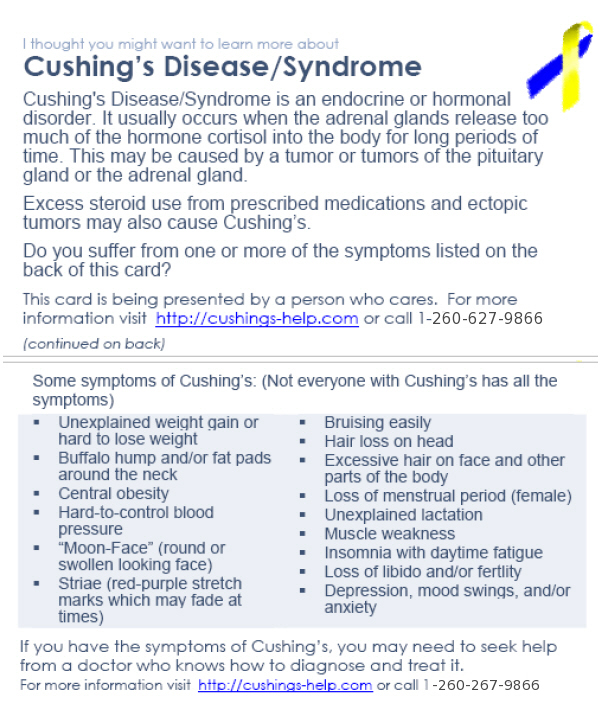By Sandra G. Boodman
Special to the Washington Post
Tuesday, December 15, 2009
As she lay in a heap, trying to figure out how badly she had hurt herself falling headfirst down a flight of stairs in the middle of the night, Rebecca Woodings grasped just how sick she really was.
For months doctors had been ratcheting up the medicines used to treat her intractable allergies. At one point she was taking 10 drugs a day and getting allergy shots. An economist who works for a large Washington law firm, Woodings, 49, told doctors she was tired; she assumed her fatigue was a consequence of her allergies, which were also causing a persistent cough. She did not tell them she was so exhausted she had to sit on the sidewalk while waiting for a bus and couldn't stand long enough to cook a meal.
Hours before she tumbled down the stairs of her Takoma Park home last June, an astute pulmonologist had figured out what was wrong -- and it had nothing to do with her lungs. That night, as Woodings tried to move the wrist she had broken in the fall, she focused on her 6-year-old son, realizing that if she had smacked her head she could have died. "I kept thinking, what would have happened to my child?"
In the fall of 2008 Woodings began feeling unusually tired. Walking less than a mile to the Metro in the morning made her break into a sweat. "It was very tiring," she said, and she recalled feeling puzzled. "I'm not terribly out of shape and I'm not overweight." Once on the Metro, Woodings made sure to get a seat; standing for 20 minutes was unthinkable.
During her annual checkup in November, her long-time internist at George Washington University discovered a Vitamin D deficiency and prescribed a short course of high-dose supplements.
By December, the fatigue was worse. Woodings had to sit down in the middle of a hymn during a church service. "All these little white-haired people around me are standing, and I couldn't," she recalled. When she mentioned the incident to a friend who works at the National Institutes of Health, she was told the symptoms sounded like a heart attack. Alarmed, Woodings immediately headed to a nearby emergency room, where an EKG and a chest X-ray showed that her heart was fine and her lungs were clear. Her father, a retired physician, suggested that maybe an antihistamine was causing her fatigue. Woodings stopped taking it and felt slightly more energetic.
By February, she was forced to sleep propped up on pillows and was taking a prescription cough syrup, which had little effect. The mother of a typically energetic kindergartner, she had started falling into bed around 8:30, when her son did. One night, she was so tired she told him to put himself to bed and crawled into bed at 8. Her allergist began administering allergy shots, which didn't help. Another doctor -- not her regular internist -- suggested she cut back on her sleep and get more exercise. Woodings replied that she was so tired she worried she might fall off a treadmill.
Routinely she arrived at the office at 9 a.m., already worn out. "It's really difficult to talk about being exhausted at a law firm," she said. "It sounds wimpy," so she didn't mention it.
In March, when she was handed a demanding new assignment with multiple deadlines, two new symptoms surfaced: Woodings began retching unpredictably -- "that damn cough," she remembered thinking -- and developed ferocious leg cramps at night. By then she noticed another peculiarity: Although she literally could not stand long enough to wait for a light to change while crossing the street, she could manage if she kept moving, walking slowly in a circle.
In early April, she went back to the allergist. He diagnosed a bad sinus infection and doubled the medications she was taking to 10 per day, including a short course of prednisone, a corticosteroid sometimes used to treat severe sinus infections.
After the first day, Woodings said, she felt markedly better. A week later the cough had disappeared and her energy slowly returned.
But by Memorial Day the fatigue was back and Woodings realized her problem wasn't allergies. She had stopped taking the allergy drugs, deciding that they might be the cause; her cough was gone. Woodings called her internist, whom she had not seen in six months. The doctor was heading out of town and Woodings decided to wait until her return rather than see a covering physician. In the meantime her physician ordered several tests, including those for Lyme disease and HIV, as well as CT scans of her lungs and sinuses.
On June 5, Woodings was told she had a possible bacterial infection in her lungs -- but not tuberculosis -- and was referred to GWU pulmonologist Susan Hasselquist. When she called to make an appointment, she was told that Hasselquist's first opening was a month away.
Desperate, Woodings decided to lie. "I said, 'I can't wait. The potential diagnosis is active TB.' " She was given an appointment for the next day.
On June 10 Woodings met with Hasselquist, who listened intently as Woodings recounted the events of the previous seven months. Unable to obtain a blood pressure using an automated cuff, Hasselquist measured it manually and found it was an alarmingly low 90/55. The lung specialist recalled being struck by how weak Woodings was: She lay down on the examining table while they talked because sitting up was too tiring. Hasselquist said she kept thinking of, and discarding, possible diagnoses. "I knew if we just kept talking I'd figure it out," she said.
Her eureka moment occurred when she zeroed in on Woodings's deep tan and asked her about it. Woodings, who is normally very fair, said that other people had remarked on it and that she hadn't spent much time in the sun.
Suddenly, Hasselquist said, she was certain what was wrong, a hunch triggered by photographs she'd seen of a ruddy-looking President John F. Kennedy, who had Addison's disease, a rare endocrine disorder that occurs when the adrenal glands become damaged and fail to produce enough cortisol and aldosterone, hormones vital for metabolic function. Most cases are the result of an autoimmune attack in which the immune system slowly destroys the adrenal glands. Woodings's dramatic improvement while taking prednisone, the steroid prescribed to treat her sinus infection, was a vital clue: It is one of the medicines used to treat Addison's.
Kennedy received an Addison's diagnosis at age 30; his sister, the late Eunice Kennedy Shriver, is also believed to have suffered from the disorder, which affects one to four of every 100,000 people, according to the National Institute of Diabetes and Digestive and Kidney Diseases.
Woodings had the classic symptoms of Addison's: progressive fatigue, muscle weakness, low blood pressure that falls further during a change in positions, and hyperpigmentation, which resembles a dark tan. The retching and legs cramps are also symptoms, although her allergies and cough are not.
Hasselquist did not mention her suspicion to Woodings because it would require confirmation from an endocrinologist. She said she suggested hospitalizing Woodings because she was so weak. When Woodings declined, Hasselquist warned her against standing up too quickly, which could cause dizziness.
After the appointment with Hasselquist, Woodings went straight home, ordered a pizza and went to bed. She awoke several hours later and headed for the bathroom to urinate. She remembers feeling dizzy, and then realizing she was at the bottom of the stairs, her wrist shattered. She managed to get up, call 911 and wake her son. Doctors in the ER set her wrist, told her to see an orthopedist because she would need surgery, then sent her home.
A few days later GWU endocrinologist Michael Irwig, to whom Hasselquist referred Woodings, confirmed the Addison's diagnosis. He prescribed prednisone and another drug Woodings will have to take for the rest her life to replace the hormones her body no longer produces.
Within a few weeks, Woodings said, she felt much better. Her energy level returned to normal, as did her blood pressure. Her tan is fading, and surgery on her wrist was successful.
"I can't fault any of the doctors," Woodings said, adding that she believes she should have called her internist early on, instead of consulting other physicians. "I think I could have described my condition a little better. I never said, 'I have to sit on the sidewalk waiting for a bus,' but rather, 'I'm tired all the time.' "
If you have a Medical Mystery that has been solved, e-mail medicalmysteries@washpost.com. To read previous mysteries, go to http://www.washingtonpost.com/health.
From http://www.washingtonpost.com/wp-dyn/content/article/2009/12/14/AR2009121402863.html
~~~~~~~~~~~~~~~
Feedback:
Woman's tale of Addison's disease proves the value of primary-care physicians
Tuesday, December 22, 2009
Of primary importance
"A piece of presidential history solved the puzzle" [Dec. 15], about the lady found to have Addison's disease, points out how crucial it is to have a primary-care focus in evaluating patients. Often patients scramble through a maze of specialists, as she did, without a strong primary-care clinician coordinating care.
My hope is that health reform will recognize the essential perspective that primary-care physicians from family medicine, geriatrics and internal medicine bring to patient care. They can save patients and the health-care system heartache and money. It is the most challenging field in medicine and the most holistic.
Our system should provide incentives for new medical school graduates to join these fields and reward these physicians appropriately. These doctors work very, very hard. Good primary-care clinicians are worth their weight in gold.
Christine Butler
Coordinator, Palliative Care Service
Sibley Memorial Hospital
Washington
From http://www.washingtonpost.com/wp-dyn/content/article/2009/12/18/AR2009121803706.html





